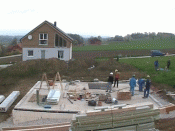Introduction
This essay aims to look at how prefabrication has affected house building. In order to do this, the essay shall cover the arguments for and against prefabrication. To achieve this, various aspects shall be covered in finding out how prefabrication has affected the housing industry and how its perceived by the public, and industry alike.
This essay aims to discuss the arguments for and against the use of prefabrication as a house building system. The essay will explore how prefabrication has formed, what it involves, and how it's perceived in the construction industry.
Prefabrication
Prefabrication means that all the elements are produced in clean, dry production plants. It's then taken to a construction site in a vehicle - protected from the weather - and assembled right away. The technique began after World War I in response to a housing shortage. It allowed a steady speed of erection, far quicker than traditional methods - within days, a new home could be watertight and airtight.
"There is only 1 solution to the problems of post-war housing - it can be expressed in 3 words - use the machine." 6
This method of construction, was hoped, that it would overcome the inefficiencies of traditional construction. It came about by the belief, that housing could be mass produced with all the benefits this enrolled in terms of cost, improved quality, and above all, considering post war demand, rapid production.
Prefabrication in the UK
This technique has been applied to urban housing for more than a century now. In the UK however, the majority of homes are still constructed using traditional methods. But within the last few years there has been an increase in the use of prefabricated homes. This driven by a range of factors including demands for faster construction and skills shortages.


